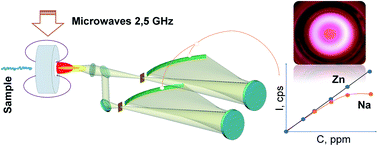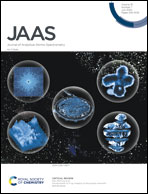Matrix effects in atmospheric pressure nitrogen microwave induced plasma optical emission spectrometry†
Abstract
We studied the matrix effects arising in the presence of elements with ionization potentials of 5.13–9.39 eV (Na, Cu, Pb, Cd, Zn) in atmospheric nitrogen plasma excited by the H011 wave in a cylindrical microwave resonator (2.45 GHz) for optical emission spectrometry “Grand-MP”. The influence of the concentration of matrix on the signal of several atomic and ionic emission lines (covering Esum values from 3.82 to 15.40 eV) of 13 elements has been studied. Compared to the 2.0% w w−1 nitric acid reference solution, the emission signal for atomic lines with Esum values lower than 5 eV was enhanced in the presence of Na, Cu, Pb but it was suppressed for the remaining atomic and ionic lines tested. It is shown that, with a decrease in the ionization potential of the matrix element, matrix effects for both atomic and ionic lines increase. The atomic temperature of the plasma is 5.2 × 103 K and does not change in the presence of up to 1% copper, cadmium, lead and zinc. The electron density is 1.9 × 1013 cm−3 and increases not only in the presence of Na, but also 1% Pb, Cu. The influence of the nebulizer gas flow rate and plasma power on the signal of atomic and ionic lines has been studied. It was shown that a decrease in atomizer gas flow to 0.4 L min−1 and an increase in plasma power up to 1650 W can reduce the matrix effects.



 Please wait while we load your content...
Please wait while we load your content...